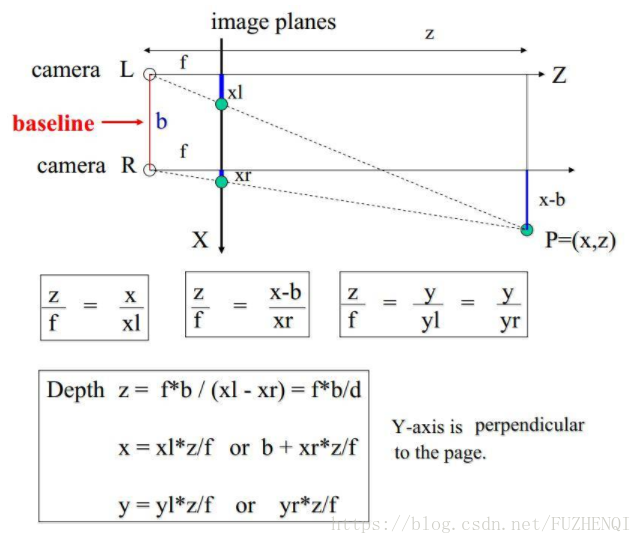### 双目立体视觉深度估计算法实现原理
双目立体视觉的核心目标是从两幅或多幅图像中恢复场景的三维信息,其中深度估计是最基础也是最重要的部分之一。以下是关于双目立体视觉深度估计算法的具体实现原理及相关代码。
#### 1. 立体视觉的基础理论
立体视觉依赖于两个摄像头获取同一场景的不同视角图像,并通过比较这些图像中的像素位置差异(称为视差)来推断物体的距离。视差 \(d\) 和深度 \(Z\) 的关系可以通过以下公式描述[^2]:
\[
Z = \frac{fB}{d}
\]
其中:
- \(f\) 是焦距,
- \(B\) 是基线距离(即两个摄像头之间的水平间距),
- \(d\) 是视差值。
该公式的前提是假设成像平面是平行的,这简化了许多实际操作中的复杂性[^4]。
#### 2. 深度估计的关键步骤
为了完成深度估计,通常需要以下几个关键步骤:
##### (1) 图像校正
由于实际拍摄过程中可能存在镜头畸变或其他误差,因此需先对输入的左、右图像进行校正。OpenCV 提供了 `stereoRectify` 函数用于生成矫正变换矩阵[^1]。
```python
import cv2
import numpy as np
# 加载相机参数
cameraMatrixL, distCoeffsL, cameraMatrixR, distCoeffsR, R, T, E, F = load_camera_params()
# 获取校正映射
RL, RR, PL, PR, Q, validPixROI1, validPixROI2 = \
cv2.stereoRectify(cameraMatrixL, distCoeffsL,
cameraMatrixR, distCoeffsR,
img_shape, R, T)
mapL_x, mapL_y = cv2.initUndistortRectifyMap(cameraMatrixL, distCoeffsL, RL, PL, img_shape, cv2.CV_32FC1)
mapR_x, mapR_y = cv2.initUndistortRectifyMap(cameraMatrixR, distCoeffsR, RR, PR, img_shape, cv2.CV_32FC1)
# 应用校正
imgL_rectified = cv2.remap(imgL, mapL_x, mapL_y, cv2.INTER_LINEAR)
imgR_rectified = cv2.remap(imgR, mapR_x, mapR_y, cv2.INTER_LINEAR)
```
##### (2) 特征匹配与视差图生成
特征匹配的目标是在左右图像之间找到对应的点对。常用的方法有基于块匹配(Block Matching)和半全局匹配(Semi-Global Block Matching, SGBM)。下面是一个使用 OpenCV 中 SGBM 方法的例子:
```python
def compute_disparity_map(imgL, imgR):
window_size = 3
min_disp = 0
num_disp = 16 * 8
stereo = cv2.StereoSGBM_create(
minDisparity=min_disp,
numDisparities=num_disp,
blockSize=window_size,
uniquenessRatio=10,
speckleWindowSize=100,
speckleRange=32,
disp12MaxDiff=1,
P1=8 * 3 * window_size ** 2,
P2=32 * 3 * window_size ** 2
)
disparity = stereo.compute(imgL, imgR).astype(np.float32) / 16.0
return disparity
```
##### (3) 深度图转换
一旦获得了视差图,就可以利用前述公式将其转化为深度图。具体过程如下所示:
```python
def convert_disparity_to_depth(disparity_map, focal_length, baseline):
depth_map = (focal_length * baseline) / (disparity_map + 1e-7) # 防止除零错误
return depth_map
```
#### 3. 完整流程示例
综合上述各步,完整的双目深度估计算法可按以下方式实现:
```python
if __name__ == "__main__":
# 步骤 1: 载入并校正图像
imgL = cv2.imread('left_image.png', 0)
imgR = cv2.imread('right_image.png', 0)
imgL_rectified, imgR_rectified = rectify_images(imgL, imgR)
# 步骤 2: 计算视差图
disparity_map = compute_disparity_map(imgL_rectified, imgR_rectified)
# 步骤 3: 将视差图转为深度图
focal_length = 500 # 单位:像素
baseline = 0.1 # 单位:米
depth_map = convert_disparity_to_depth(disparity_map, focal_length, baseline)
# 显示结果
plt.figure(figsize=(10, 5))
plt.subplot(1, 2, 1), plt.imshow(disparity_map, cmap='gray'), plt.title("Disparity Map")
plt.subplot(1, 2, 2), plt.imshow(depth_map, cmap='jet'), plt.title("Depth Map")
plt.show()
```
---
###







 本文探讨了为何双目相机能获取深度信息而单目相机不能,指出人眼的先验知识和运动恢复结构在单目深度推断中的作用。通过理想双目相机成像模型,解释了深度值计算的几何原理,强调了相机焦距、基线长度和视差在深度估计中的关键作用。
本文探讨了为何双目相机能获取深度信息而单目相机不能,指出人眼的先验知识和运动恢复结构在单目深度推断中的作用。通过理想双目相机成像模型,解释了深度值计算的几何原理,强调了相机焦距、基线长度和视差在深度估计中的关键作用。
 最低0.47元/天 解锁文章
最低0.47元/天 解锁文章
















 1068
1068

 被折叠的 条评论
为什么被折叠?
被折叠的 条评论
为什么被折叠?








